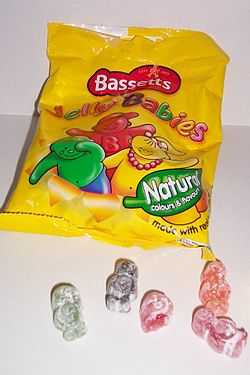Jelly Babies
| Jelly Babies | |
|---|---|
|
Bassett's jelly babies | |
| Alternative names | Peace babies |
| Type | Gummi candy |
| Place of origin | United Kingdom |
| Region or state | Sheffield |
| Creator | Bassett's |
| Main ingredients | Gelatin |
|
| |
Jelly Babies are a type of soft sugar candy or jelly that are shaped as babies in a variety of colours. They were first manufactured in England.
History
The sweets were originally called "unclaimed babies", invented in 1864 by an Austrian immigrant working at Fryers of Lancashire.[1] In 1918 they were produced by Bassett's in Sheffield as "Peace Babies" to mark the end of World War I. Production was suspended during World War II due to wartime shortages. In 1953 the product was relaunched as "Jelly Babies". In March 1989 Bassett's was taken over by Cadbury-Schweppes.
Each Bassett's jelly baby now has an individual name and shape, colour and flavour: Brilliant (red - strawberry), Bubbles (yellow - lemon), Baby Bonny (pink - raspberry), Boofuls (green - lime), Bigheart (black - blackcurrant) and Bumper (orange). The introduction of different shapes and names was an innovation, circa 1989, prior to which all colours of jelly baby were a uniform shape. In 2007, Bassett's jelly babies changed to include only natural colours and ingredients.[2]
There are currently several other brands of jelly babies, as well as supermarket own brands. A line of sweets called Jellyatrics were launched by Barnack Confectionery Ltd to commemorate the Jelly Baby's 80th birthday.[3]
Like most other gummi sweets, they contain gelatin. Jelly babies manufactured in the United Kingdom tend to be dusted in starch which is left over from the manufacturing process where it is used to aid release from the mould. Jelly babies of Australian manufacture generally lack this coating.

Jelly babies are similar in appearance to gummi bears, which are better known outside the United Kingdom, though the texture is different — jelly babies have a firmer outer layer and a softer, less rubbery centre, making them more similar to the American jelly bean or Belgian Cuberdon.
A popular science class experiment is to put them in a strong oxidising agent and see the resulting spectacular reaction. The experiment is commonly referred to as "screaming jelly babies".
In popular culture
When Beatlemania broke out in 1963, fans of The Beatles pelted the band with jelly babies (or, in the USA, the much harder jelly beans) after it was reported that George Harrison liked eating them.[4][5][6]
In the British television programme Doctor Who, jelly babies were often mentioned in the classic series. First seen being consumed by the Second Doctor, they became most associated with Tom Baker's Fourth Doctor, who had a predilection for offering them to strangers in order to defuse tense situations. The Fifth, Sixth, Seventh, Eighth, Eleventh, and Twelfth Doctors also offered them up in different episodes. The Doctor's nemesis the Master in "The Sound of Drums" offers them to his wife on board the Valiant.
In May 2013 Australian singer Alison Hams released "Jelly Baby Song"[7] - its content alluding to the consumption of jelly babies by Type 1 Diabetics to overcome hypoglycaemic episodes[8] - as a way to raise awareness for Type 1 Diabetes for JDRF Australia (Juvenile Diabetes Research Foundation)[9] who sell especially-packaged jelly babies as the focus of their annual "Jelly Baby Month" campaign.[10]
In 2009, a poll of 4,000 British adults voted jelly babies their 6th favourite sweet.[11]
References
- ↑ Sweets: The History of Temptation, Tim Richardson, Random House, 2002, ISBN 9780553814460
- ↑ "Confectionery giants cut use of artificial additives".
- ↑ Martin, Nicole (18 March 1999). "Jellyatrics revive those sweet memories". Irish Independent.
- ↑ "Letter reveals The Beatles' fear of jelly baby fans" Daily Mirror 15/05/2009
- ↑ "George Harrison's 1963 plea: stop throwing jelly babies at Beatles" The Times 14 May 2009
- ↑ "The secret life of jelly beans" LA Times 19 March 2008
- ↑ Jelly Baby Song
- ↑ Baby Song Lyrics.pdf
- ↑ JDRF media release, 30 April 2013
- ↑ JDRF "Jelly Baby Month"
- ↑ Chris Irvine (27 August 2009). "Fizzy cola bottle named Britain's favourite sweet of all time". The Telegraph (London). Retrieved 1 April 2012.
